Join us “Behind the Fin” with Dennis Cook, retired, Rocky Mountain Flycasters Chapter Youth Chairperson in Fort Collins, Colorado.
How long have you been a TU member?
Sixteen years. I joined TU originally on a free TU membership offer from when I purchased a pair of wading boots.
Why did you become a member and what chapter are you involved with?
After the free year expired, in January 2003 I joined as a paid member with Cherry Creek Anglers Chapter when I lived in Parker, a Denver suburb. Ten years ago we moved to Fort Collins and I transferred memberships into the Rocky Mountain Flycasters Chapter here.
What made you want to be involved with TU?
I was enjoying reading the local chapter’s newsletters, and natural outdoors conservation has always held a soft spot in my heart. Plus, I also was looking for a way to connect with other fly fishing people.
What is your favorite activity or project you have done with TU?
At Cherry Creek Anglers I was active on the chapter board, and also served Colorado TU as a chapter development volunteer. Here at Rocky Mountain Flycasters I’ve focused on youth education. My favorite project has been establishing a six-day River Conservation & Fly Fishing Youth Day Camp here in Northern Colorado, that is modeled loosely similar to the state residential youth camp, and that 2018 will be our day camp’s ninth year. Additionally, we have built a solid, overall youth education program, including multiple
years’ success with Trout in the Classroom (high schools), participating annually with three school systems’ elementary school grades Water Festivals, establishing a multi-years relationship supporting Colorado State University’s Environmental Learning Center’s middle school age summer camp programs, and fostering the CSU Five Rivers Fly Fishing Club now in its third year.
I know you won’t tell me your favorite spot, but what is your second favorite place to fish or favorite fishing story?
I’ve fished the Cache La Poudre River for about twenty-five years and it remains my primary fishery, especially the far upper canyon stretches where I also fish some of the small tributaries. Each year I enjoy a few multi-day trips to many of the other great fisheries in here in Colorado, Wyoming and occasionally Montana. All hold remnants as something of a favorite spot, each in its own way.
What does being a part of TU mean to you?
I have a great sense of identity and pride being a TU member, both for what I can contribute…and also for the favorable accomplishments and impacts TU makes nationally in specific conservation advocacy and restorations. The growth of TU’s outreach programs and conservation impact nationally across the sixteen years I’ve been able to observe has been extraordinary. TU does not just talk a good game, it makes really good things happen!
What else do you do in your spare time or work?
In retirement I’ve kind of become a one act pony, enjoying my fly fishing and TU activities. With that, after a part-time job in a retail store’s fishing department, and all the household, yard and activities of a large family, I’m ready to sleep well every night.











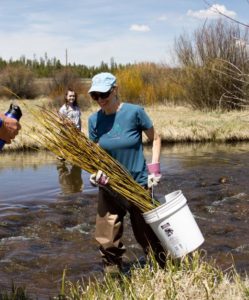 The group’s inaugural project at Fraser Flats aimed to restore a roughly one-mile stretch of the Fraser between the towns of Tabernash and Fraser, with the goal of providing healthy habitat for trout even during periods of reduced flows. The Fraser in this section had become too wide and shallow, resulting in sedimentation and high temperatures that smothered bug life and pressured coldwater-loving trout.
The group’s inaugural project at Fraser Flats aimed to restore a roughly one-mile stretch of the Fraser between the towns of Tabernash and Fraser, with the goal of providing healthy habitat for trout even during periods of reduced flows. The Fraser in this section had become too wide and shallow, resulting in sedimentation and high temperatures that smothered bug life and pressured coldwater-loving trout.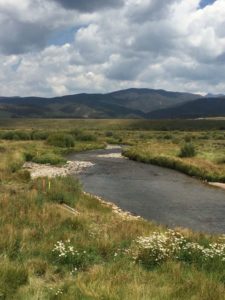 Colorado Parks and Wildlife conducted a fish survey on Oct. 5, shortly after completion of the project, and found dramatic increases in the biomass of brown and rainbow trout in the stretch compared to previous surveys, and an even larger increase in numbers of larger (14" and up) fish.
Colorado Parks and Wildlife conducted a fish survey on Oct. 5, shortly after completion of the project, and found dramatic increases in the biomass of brown and rainbow trout in the stretch compared to previous surveys, and an even larger increase in numbers of larger (14" and up) fish.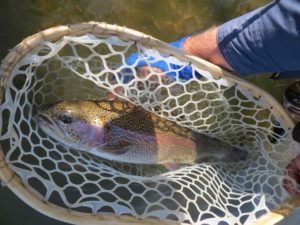
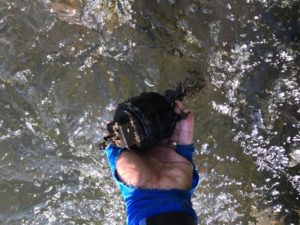
 What made you want to become involved with TU?
I grew up loving to volunteer and help others; during my involvement with the Boy Scouts of America from Cub Scout to Eagle Scout and beyond, I get a great sense of satisfaction from philanthropic endeavors. Oh- and I love to fish, so I should do my part to keep our waters clean, cold and fishable for generations to come. There is nothing better than a day on the river, (besides a day on the river catching fish) so I love being part of an organization where our work benefits my favorite pastime!.
What made you want to become involved with TU?
I grew up loving to volunteer and help others; during my involvement with the Boy Scouts of America from Cub Scout to Eagle Scout and beyond, I get a great sense of satisfaction from philanthropic endeavors. Oh- and I love to fish, so I should do my part to keep our waters clean, cold and fishable for generations to come. There is nothing better than a day on the river, (besides a day on the river catching fish) so I love being part of an organization where our work benefits my favorite pastime!. What else do you do in your spare time or for work?
I am a water resource engineer and I specialize in stream restoration and watershed management. If I am not fishing I am skiing. My entire life from professionally to personally revolves around water. My wife and I love backpacking, hiking to cool spots and exploring our amazing state with our dogs.
What else do you do in your spare time or for work?
I am a water resource engineer and I specialize in stream restoration and watershed management. If I am not fishing I am skiing. My entire life from professionally to personally revolves around water. My wife and I love backpacking, hiking to cool spots and exploring our amazing state with our dogs.
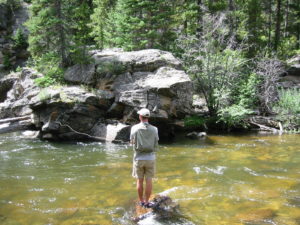 I’ve really started to love high alpine lakes, particularly backpacking into them. The solitude and natural beauty always recharges my batteries. Plus I have learned enough to usually catch some wild trout for supper. My favorite river fishing is on a stretch of the Colorado River, where my brother and I catch 18-20+ inch rainbow and brown trout. I will leave that stretch unidentified per my brother’s request.
I’ve really started to love high alpine lakes, particularly backpacking into them. The solitude and natural beauty always recharges my batteries. Plus I have learned enough to usually catch some wild trout for supper. My favorite river fishing is on a stretch of the Colorado River, where my brother and I catch 18-20+ inch rainbow and brown trout. I will leave that stretch unidentified per my brother’s request.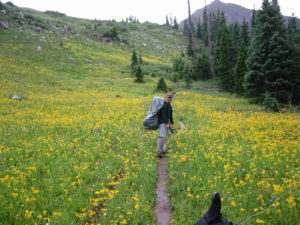 Since moving into the mountains, I have started a new career in elder care, trying to keep folks in their homes. A new focus of my fishing is the 9 wt rod I recently purchased. I’m getting into kayak fly fishing for larger fish in the Florida flats and will be fishing for some pike this summer on the Rio Grande. Love new adventures.
Since moving into the mountains, I have started a new career in elder care, trying to keep folks in their homes. A new focus of my fishing is the 9 wt rod I recently purchased. I’m getting into kayak fly fishing for larger fish in the Florida flats and will be fishing for some pike this summer on the Rio Grande. Love new adventures.

